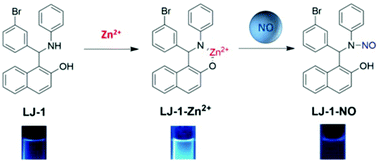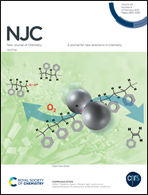A novel fluorescence sensor for relay recognition of zinc ions and nitric oxide through fluorescence ‘off–on–off’ functionality†
Abstract
A novel fluorescent sensor (LJ-1) as a Zn2+ and nitro oxide (NO) relay recognition probe was designed and synthesized based on the aminomethylnaphthol moiety. In PBS buffer, LJ-1 showed high selectivity and ratiometric fluorescence response to Zn2+ on the basis of the intermolecular charge transfer (ICT) mechanism. Spectroscopic titrations showed that LJ-1 could be recognized as a fluorescent turn-on probe with a 10−8 M detection level. Subsequently, the resultant LJ–Zn2+ complex could act as a turn-off probe for the detection of NO in several seconds at the 10−8 M detection level. Furthermore, the binding modes of Zn2+ and NO with LJ-1 were elucidated by a computational study using density functional theory (DFT). The results demonstrated that LJ-1 can serve as a ratiometric fluorescent probe for relay recognition of Zn2+ and NO in an aqueous medium at physiological pH value.



 Please wait while we load your content...
Please wait while we load your content...